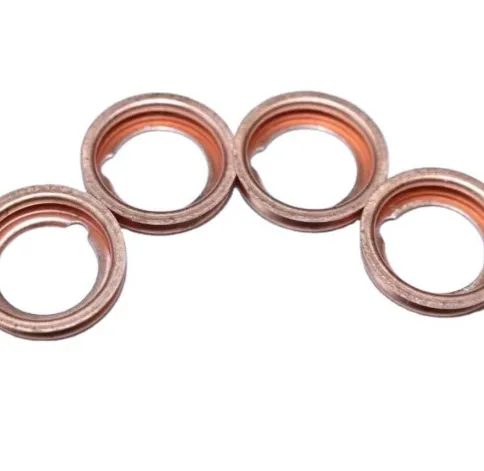The Essential Guide to Sump Plug Washers: Types, Sizes, and Why They Matter
When performing an oil change, most car owners focus on the oil type and filter. But there’s a much smaller component that plays a major role in preventing leaks and maintaining engine health: the sump plug washer. This often-overlooked item ensures a proper seal between your sump plug (also known as the oil drain plug) and the oil pan. Whether you're using a 14mm sump plug washer, a rubber sump plug washer, or a traditional sump plug crush washer, choosing the right washer is crucial for a leak-free oil change.

Why the Sump Plug Washer Is So Important
A sump plug washer (or sump nut washer) is a small but critical part of your engine’s oil system. Its job is to seal the connection between the oil sump plug and the engine’s oil pan, preventing oil from seeping out after an oil change. Without a reliable washer, even a perfectly tightened drain plug may allow slow oil leaks—leading to engine damage over time.
There are several types of sump plug washers used in automotive applications:
Crush washers: Typically made of soft metal (like aluminum or copper), they deform to create a tight seal. These are often one-time use.
Rubber washers: These may be stand-alone or bonded to a metal backing. They can sometimes be reused but should be inspected carefully.
Composite or fiber washers: Less common but used in some older vehicles or motorcycles.
Replacing the washer each time you change the oil is highly recommended. Reusing a crushed or worn washer can compromise the seal, allowing oil to leak past the sump plug and onto your driveway—or worse, lead to a low-oil condition in the engine.
Choosing the Right Size: What Is a 14mm Sump Plug Washer?
Washer sizes are typically based on the diameter of the drain plug bolt. For example, a 14mm sump plug washer is designed for a drain plug with a 14mm thread diameter. These washers are commonly found in many European and Japanese vehicles. You may also see them labeled as M14 sump plug washers—the "M" simply stands for metric.
To ensure a proper fit, you’ll need to match both:
Inner diameter (ID): It must fit snugly around the sump plug threads.
Outer diameter (OD) and thickness: Must be appropriate to sit flat against the oil pan surface and deform correctly (if it’s a crush washer).
Here are a few common washer types you might encounter:
M14 copper crush washer: Great for high-heat and corrosion resistance.
M14 aluminum crush washer: Softer than copper, seals with less torque—ideal for aluminum pans.
M14 rubber sump plug washer: Offers flexibility and reusability, but must be checked for aging or cracking.
Not all M14 washers are interchangeable, so always confirm fitment before installation.
Metal vs. Rubber: Which Sump Plug Washer Is Better?
The choice between a metal sump plug crush washer and a rubber sump plug washer depends on your vehicle’s design and your oil change preferences.
Crush washers (usually aluminum or copper) are designed to be replaced at each oil change. They’re reliable, inexpensive, and create a permanent deformation that seals against both the sump plug and pan. However, they should never be reused—doing so can lead to slow leaks or over-tightening of the plug.
Rubber washers, or bonded rubber-metal combinations, are more forgiving. They’re easier to install, don’t require much torque, and can sometimes be reused for multiple oil changes—if they remain in good condition. However, rubber degrades over time due to oil exposure and heat cycles, so they should still be inspected and replaced as needed.
If your oil pan or drain plug is aluminum, a soft aluminum or rubber washer can prevent thread damage from over-torquing. Always check the service manual or consult a mechanic for the recommended washer type for your vehicle.
Best Practices for Replacing a Sump Plug Washer
Whether you're using a sump nut washer, sump plug crush washer, or a rubber sump plug washer, following these steps can help ensure a leak-free oil change:
Always remove and replace the washer during each oil change, unless it’s a known reusable rubber type in perfect condition.
Inspect the drain plug threads and oil pan mating surface. Clean off old oil or debris that may compromise the seal.
Use a torque wrench to tighten the sump plug to the manufacturer’s specification. Over-tightening can crush the washer too much or damage the oil pan.
Keep spare washers in your garage—especially if you do your own oil changes regularly.
Check for drips after starting the engine post-oil change. If you notice any signs of leakage, turn off the engine, recheck torque, and inspect the washer.
Even a well-installed washer can fail if the wrong size is used, the surfaces are dirty, or the plug is over-tightened. Using the correct washer each time is a small effort that goes a long way toward maintaining your engine’s integrity.
Whether you’re using a 14mm sump plug washer, a rubber sump plug washer, or a traditional sump plug crush washer, understanding the importance of this small part is key to effective oil system maintenance. It's cheap insurance against oil leaks and major engine damage. Always replace the washer with the correct type and size, and you'll enjoy clean, safe oil changes every time.
-
Seal 12x20x5: Precision Radial Shaft Seals for Industrial Reliability
Warta Nov.24,2025
-
Seal 12x18x5: Essential Guide to Specifications, Applications & Vendors
Warta Nov.24,2025
-
Understanding Seal 12 20 5: Applications, Specifications & Industry Insights
Warta Nov.23,2025
-
Durable Oil Seal 85x110x12 – Reliable Sealing Solutions for Industry
Warta Nov.23,2025
-
Durable and Precise Oil Seal 75x95x10 for Efficient Machinery | YJM Seal
Warta Nov.22,2025
-
Durable Oil Seal 75x100x10 for Reliable Industrial Performance | YJM Seal
Warta Nov.22,2025
-
High-Quality Oil Seal 65x90x10 | Durable & Reliable Sealing Solutions
Warta Nov.22,2025
Kategori produk















